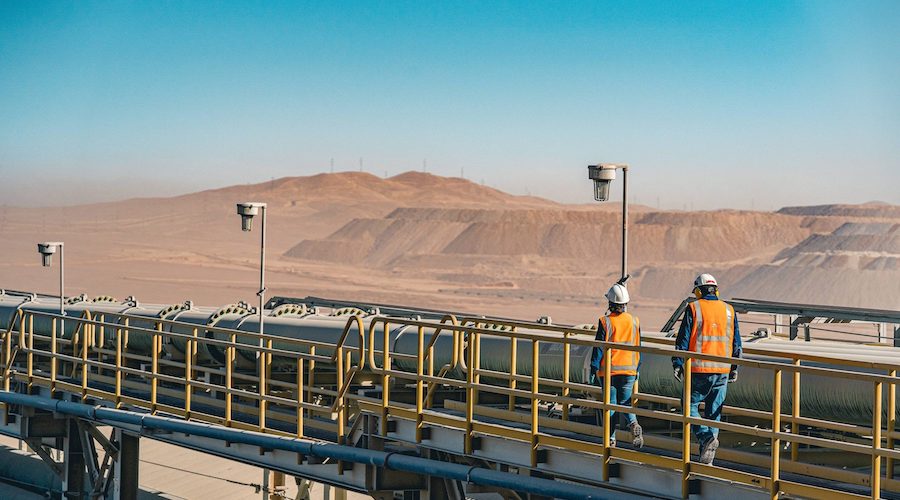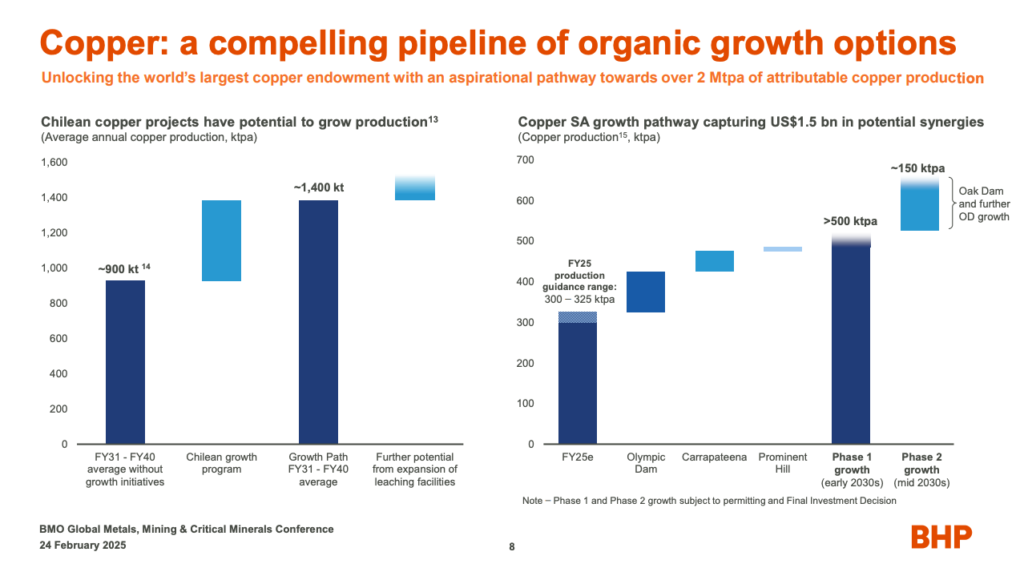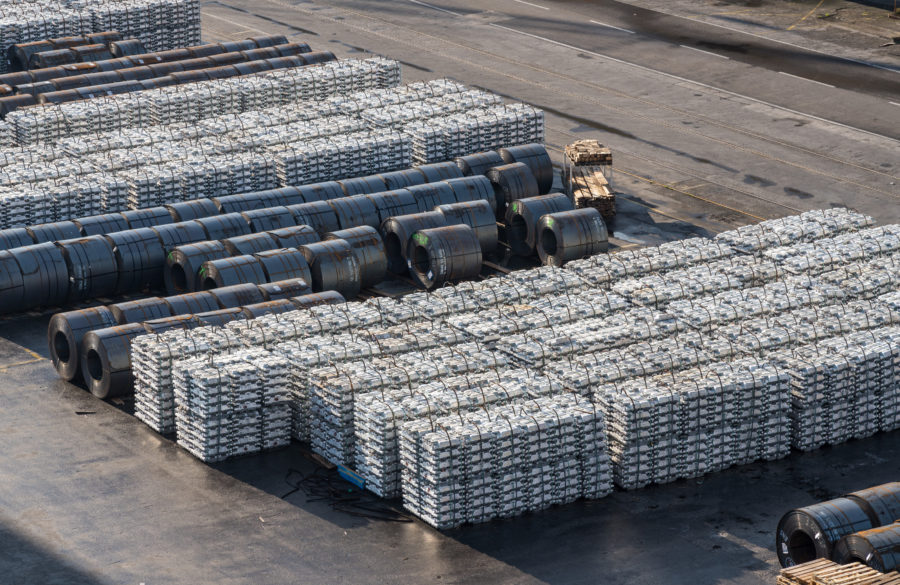BHP seeks copper deals while metal is hot

BHP (ASX: BHP) continues its global search for copper to meet soaring demand driven by the energy transition, but a shortage of high-quality deposits— particularly in stable jurisdictions —remains a challenge.
Over the past five years, the world’s largest miner has shifted its focus. In 2020, iron ore dominated its earnings and investment, but today it accounts for less than a quarter. In contrast, copper now receives half of BHP’s capital expenditure.
A barrier for BHP is its cautious approach that favours stability over high-risk, high-reward ventures. Competitors such as Glencore (LON: GLEN) and Rio Tinto (ASX: RIO) have embraced volatile regions—Kazakhstan, the Democratic Republic of Congo, Mongolia, and Guinea. BHP instead has traditionally stuck to safer ground: Australia, Brazil, Canada, Chile, Peru, and the United States. Even its failed $49 billion bid for Anglo American (LON: AAL) last year was carefully structured to exclude South African assets.
There are benefits to this caution, Bloomberg Opinion columnist David Fickling writes. Political instability poses operational and reputational risks. Rio Tinto’s 28-year struggle with its Simandou iron ore mine in Guinea resulted in executive shake-ups and costly bribery settlements. Glencore has also faced challenges, paying over $1 billion in fines for bribery and market manipulation.
Yet, mineral-rich regions rarely align with political stability, compelling even BHP to step outside its usual comfort zone.
Last year, it completed a $2 billion deal for a 50% stake in Argentina’s Filo del Sol copper project alongside Lundin Mining (TSX: LUN). Argentina, long avoided by major miners due to its volatile political and legal environment, has become more attractive under libertarian President Javier Milei’s pro-mining policies. Still, Argentina’s track record of policy instability makes the investment a calculated risk.
With large-scale mergers and acquisitions reshaping the mining industry — Glencore and Rio Tinto reportedly discussed a potential blockbuster deal — the timing could be right for BHP to pursue a long-rumoured target: Freeport-McMoRan, the world’s top copper producer.
Such a deal would immediately double BHP’s copper output and secure control over four of the five largest copper mines. Even with such a deal, BHP’s market share in global copper production would remain under 20%, staying within limits unlikely to trigger antitrust scrutiny.
Expansions over acquisitions
Chief executive Mike Henry has expressed a preference for expanding existing operations rather than pursuing major acquisitions, particularly after the Anglo American bid fell through. Speaking at the BMO Global Metals, Mining & Critical Minerals Conference that kicked off on Sunday, he presented data arguing that organic growth offers better returns than takeovers.
Henry highlighted the company’s emphasis on growing and optimizing its Chilean assets. BHP is targeting annual production in Chile of 1.4 million tonnes per annum in the 2030s. The upgrades include a new concentrator at Escondida and the expansion of an existing concentrator, with total Chilean copper growth at a planned capex intensity of $23k/t.
Its South Australia copper business, which combines Olympic Dam, Prominent Hill, Carrapateena, and the Oak Dam projects, has the potential to increase production towards 500,000-650,000 tonnes per annum from the mid-2030s.

“While attractive from a value accretion basis, organic production growth in copper will take a decade to come through given the long-term nature of copper mine developments,” Maurizio Carulli, energy and materials analyst at Quilter Cheviot, said.
“It is possible that BHP would consider M&A opportunities in the future and given the company’s size, it would likely be a predator rather than prey,” Carulli noted.
A key obstacle to a Freeport deal is the giant Grasberg copper-gold mine — Freeport’s flagship and a historically problematic asset. The operation sits in a region that has seen separatist violence and security concerns.
Environmental woes also pose a challenge. Grasberg’s practice of dumping mine waste into nearby rivers is at odds with BHP’s efforts to distance itself from past tailings disasters, such as those at Papua New Guinea’s Ok Tedi mine and Brazil’s Samarco iron ore project.
Grasberg’s risks have diminished in the past five years. A 2018 agreement between Freeport and the Indonesian government resulted in a state-owned entity taking a majority stake, reducing the likelihood of nationalization. Separatist violence in the mine’s operational zone — an area slightly smaller than Canada’s Ottawa — has significantly declined in recent years.
Freeport has also improved its corporate reputation. It now ranks higher than BHP in the World Benchmarking Alliance’s human rights index and earned the Copper Mark in 2023, an industry certification for responsibly sourced metal—including Grasberg’s waste management practices.
“The world’s greatest mineral deposits last for generations, but opportunities to acquire them are rare. For BHP, that moment may have arrived. Henry would do well to strike while the copper is hot,” Fickling concluded.
(With files from Bloomberg)
More News
Column: Europe’s future metals strategy hindered by current crisis
Chinese over-capacity and high energy prices have accelerated the long-term decline of European steel and aluminum production.
March 29, 2025 | 02:25 pm
Anglo starts talks with banks on possible De Beers IPO
Anglo is pursuing a dual-track process in its effort to exit De Beers by trying to find a buyer for the struggling business.
March 28, 2025 | 12:19 pm
{{ commodity.name }}
{{ post.title }}
{{ post.excerpt }}
{{ post.date }}



Comments